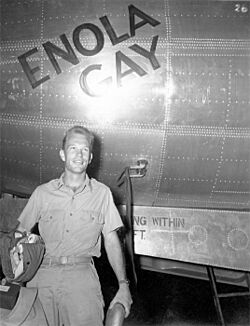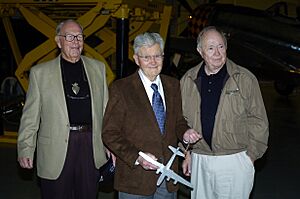Morris R. Jeppson facts for kids
Quick facts for kids
2LT Morris R. Jeppson
|
|
|---|---|
 |
|
| Born | June 23, 1922 Logan, Utah, U.S. |
| Died | March 30, 2010 (aged 87) Las Vegas, Nevada, U.S. |
| Allegiance | |
| Service/ |
|
| Years of service | 1942–1946 |
| Rank | |
| Battles/wars | World War II |
| Awards | |
Morris Richard Jeppson (June 23, 1922 – March 30, 2010) was an American soldier who played a key role in World War II. He was a Second Lieutenant in the United States Army Air Forces. Morris Jeppson was part of the crew on the Enola Gay airplane. This plane dropped the first atomic bomb on the city of Hiroshima, Japan on August 6, 1945.
Contents
Early Life and Education
Morris Jeppson was born in Logan, Utah. He studied physics at the University of Nevada, Reno. In 1942, at age 19, he joined the United States Army Air Corps.
After basic training in Florida, he received special electrical engineering training. He studied at famous universities like Yale University, Harvard University, and MIT. Later, he worked with scientists from Los Alamos National Laboratory at Wendover Air Force Base in Utah. There, he helped develop how bombs would fire.
The Hiroshima Mission
Second Lieutenant Jeppson had a very important job during the flight to Hiroshima. He worked with Captain William Sterling Parsons of the U.S. Navy. Their task was to arm the atomic bomb, nicknamed "Little Boy".
The bomb was kept safe from exploding too early by three special safety plugs. These plugs stopped electricity from reaching the bomb's firing system. Each plug looked like a car cigarette lighter and had a green cap. Jeppson's job was to remove these three green safety plugs. He then replaced them with three red "arming" plugs. He did this just before the plane reached its target.
This action meant Jeppson was the last person to touch the "Little Boy" bomb before it was dropped. He talked about this moment in the BBC documentary Hiroshima.
Life After the War
In September 1945, Jeppson received the Silver Star. This award recognized his brave service to his country. In the 1950s, he worked as a scientist at Lawrence Livermore National Laboratory in California. He helped develop hydrogen thermonuclear weapons.
Later in his career, he helped create new technologies. These included microwave technology and special parts used to make helicopters stable. After retiring as a physicist, Jeppson lived in Las Vegas with his second wife, Mollie.
For many years, Jeppson did not talk publicly about the Hiroshima mission. He worried about how people might react towards him and his family. But starting in 1985, he began to share his story. On the 40th anniversary of the bomb dropping, he gave an interview about his role.
Controversy and Later Years
In June 2002, a debate started over some safety plugs Jeppson had kept. He had one of each type of plug from the mission. These plugs were put up for sale in an auction. However, the U.S. government tried to stop the sale. They said the plugs were secret government material.
A judge, Susan Illston, decided against the government. This allowed the sale to go forward. The plugs were eventually sold to a retired physicist named Clay Perkins for $167,000.
In 2005, a reunion for the 60th anniversary was planned in Guam, but it did not happen. Time Magazine published a special issue about the 60th anniversary of the bombings. Jeppson and other crew members shared their experiences. Jeppson also spoke about his role in the BBC drama documentary Hiroshima in 2005. An actor played his part in removing the safety plugs.
Death
Morris Jeppson passed away on March 30, 2010, in Las Vegas. He was survived by his wife, brother, three children, five grandchildren, and three great-grandchildren. After Jeppson's death, Theodore Van Kirk became the last surviving crew member of the Enola Gay. Van Kirk later died on July 28, 2014.
Military Awards
Morris Jeppson received several important military awards for his service:
- Silver Star
- Air Medal
- Air Force Outstanding Unit Award
- American Campaign Medal
- Asiatic-Pacific Campaign Medal
- World War II Victory Medal


